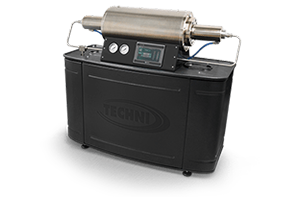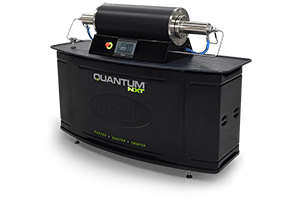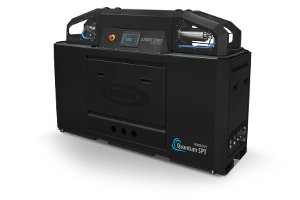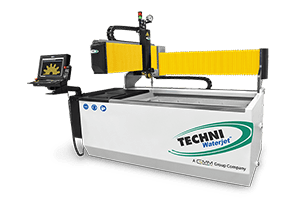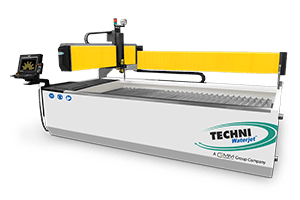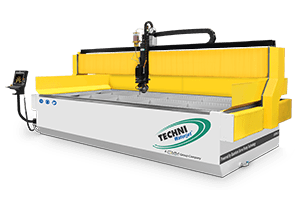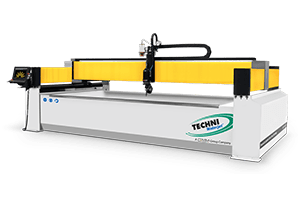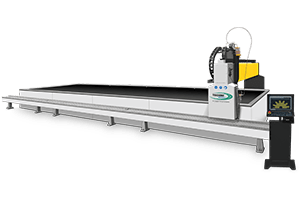Frequently Asked Questions
Below are the most common questions that we face when customers enquire about one of our Waterjet cutting machines. We have grouped our questions to make it easy for you to find the information you are looking for. If you simply don’t find the question and answer you are looking for, you can ask a question of your own either via the form below or by submitting it within our chat bot feature.
 General Inquiries
General Inquiries
New around here? Start with the basics. Materials
Materials
Learn about cutting materials. Pump
Pump
Learn more about waterjet pumps Support
Support Software
Software
Learn more about waterjet pumps Ask a Question
Ask a Question
How does a waterjet work?
There are two main steps involved in the waterjet cutting process. First, the ultra-high-pressure pump or Electric Servo pump generally pressurises normal tap water pressure levels above 50,000 psi (3450 bar) to produce the energy required for cutting. Second, the water is then focused through a small precious stone orifice to form an intense cutting stream. The stream moves at a velocity of up to 2.5 times the speed of sound, depending on how the water pressure is exerted. The process is applicable to both waters only and abrasive jets. For abrasive cutting applications, abrasive garnet is fed into the abrasive mixing chamber, which is part of the cutting head body, to produce a coherent and an extremely energetic abrasive jet stream.
The waterjet system uses Ultra High Pressure created by the high pressure pump.
The output water is pumped at high pressure to the CNC cutting machine.
The water flow is metered by the cutting head. The Diamond Orifice inside creates a very small diameter jet.
In Water Only applications – the jet directly from the orifice makes the cutting. Typically an Orifice diameter (0.007” / 0.175mm) is used. The jet is concentrated over a very small area and can easily cut though softer materials.
In Abrasive Waterjet applications – after passing the Orifice (typically 0.012” / 0.30mm), the jet then passes through a mixing chamber. This creates a venturi effect which draws in the abrasive. The abrasive clings to the water stream and is directed into the Focus Tube (or Nozzle Tube). A focused Abrasive Waterjet stream emerges which can cut through any material.
How much does a Techni Waterjet generally cost?
Typically, how fast can a waterjet cut and how does it hold its accuracy?
Cutting Speed depends on the following variables:
Material type - harder materials cut more slowly
Material thickness - thicker material of a given type cut more slowly
Waterjet Pressure - higher pressure cuts faster
Volume of Abrasive – higher abrasive in the stream cuts faster
Cut quality desired – rougher finish is a faster cut
For example, water only cutting of things like rubber or cork gaskets, our waterjet machines can cut at up to 17.5m/min (690”/min). Whereas, 25mm (1”) thick Aluminum is typically cut at speeds of approx. 250mm/min (10”/min)
We offer software that calculates the approximate cutting speeds for a wide variety of materials.
How accurate are Waterjet machines?
Part accuracy depends on many factors;
Firstly, it will depend on the accuracy of the Waterjet machines motion control. When the linear encoder feedback system is included on a Techni machine, we can achieve positional accuracy of 0.02mm (0.001”) per axis.
- However, there are a number of other factors which will determine the accuracy of the part being produced;
- The size and consistency of the kerf. Kerf is the amount of material removed during the cutting process. Because waterjet is an erosion process, the amount of time the stream sits in 1 position will affect the amount of material being removed, or the width of the kerf. Therefore, Techni waterjets software automatically adjusts the kerf width to suit the speed, material, and other relevant factors. This minimises any reduction in part accuracy due to the varying nature of a waterjet kerf width.
- The stand-off distance between the cutting head and the workpiece. As the nozzle gets closer to the workpiece, it increases the kerf and as it gets further away it reduces the kerf. Therefore, the more consistent the stand-off height can be maintained, the more accurate the part will be. Therefore Techni has developed a number of options, including Laser Mapping and Touch Probing to help produce accurate parts.
Generally speaking, Waterjet machines will consistently produce parts which within +/- 0.25mm (+/-0.010”), and can produce parts down to +/-0.05mm (+/-0.002”) if an accurate standoff and consistent kerf are maintained.
If I still need help deciding which system I need, whom should I get into contact with?
Our friendly sales and applications team will be happy to review your application and help you determine the right system for you. If you want to learn more about our systems before contacting one of our specialists, please visit our Waterjet systems page here.
How long does it take to set up the system?
Our Cantilever type machine comes 90% assembled and takes around 1.5 days to commission on-site.
Gantry type machines require around 3 days to commission.
Commissioning pump, hopper, chiller, abrasive removal system take around 0.5 days per option.
How would I get it into my workshop?
Advice for unloading will be provided by Techni. Typically clients are used to unloading materials from trucks and may already have the necessary equipment, such as a large forklift or overhead crane.
What are the advantages of waterjet cutting verse CNC machining?
Waterjets can cut shapes closer together due to a <1mm tool radius
Less setup and tooling time - one jet makes all cuts
Waterjets cut through the material from top to bottom, they cannot profile cut like a CNC tool.
How can I determine whether my application will require abrasive?
Abrasive
Metals, Glass, Stone, Wood, Acrylics,
Water only
Rubber, Textile, Plastics like PVC, Silicone, Insulation materials,
Fibrous (Carbon / Glass) products and Cement board in thin sheet form
In order to determine whether abrasive will be required for your application we will need to understand your process a little further. Please speak to one of our specialists by calling us on 61 3 8359 5100. You can also check out our abrasive page here for more information.
How is the abrasive added to waterjet?
Abrasive is generally stored in bulk hoppers of between 250kg to 2Tonne. The abrasive is automatically fed from the bulk hopper to a small metering hopper mounted on the machine. The metering hopper allows the correct amount of garnet to feed to the cutting head. As the waterjet passes through a mixing chamber it creates a venturi effect which draws in the abrasive. The abrasive clings to the water stream and is directed into the Focus Tube (or Nozzle Tube) and is then blasted into the material to begin the erosion process.
Is there much maintenance associated with one of your machines?
Our Electric Servo pump is the quickest to service on the market due to thoughtful design surrounding the HP cylinders and frame.
The ESP overall contains much less components than a hydraulic intensifier. The main difference being our power transmission comes from a sealed servo motor unit, whereas a hydraulic intensifier is made up of multiple connected components which all require their own regular maintenance.
The ESP also controls the pressure much better than any other type of UHP pump, this causes less fatigue on HP bodies and pipework – greatly extending their service life by over 5:1.
HP components - All waterjets use theoretically the same components to generate pressure and deliver to application, including:
- Plungers (Basically like a Piston)
- HP Seals (Basically like Piston rings)
- Check Valves. Controls water flow in one direction
- Dump (or Release) Valve – (depressurises the system safely)
The moving parts of these components are consumable and will require service over time. Water quality and operating pressure are the main factors
Lubrication / cooling system – for the power transmission pumping components
Oil filters –
Oil
What is the running cost of this machine per year?
A typical abrasive waterjet will cost between $12/hr and $30/hr to operate, depending on material and how fast you want to cut.
Do you provide training on how to operate the machine safely?
Techni understand that excellent training = excellent customer experience
During installation days are planned for operator and maintenance training which will give your people the knowledge and confidence to operate and maintain the machine to a high standard.
Follow up training for new staff is also available later on.
Can your machines run without staff?
Yes. Techni has spent a lot of time developing our systems to allow for “Lights out Cutting”. We have developed and implemented a sensor to the cutting head to stop the machine if there is anything wrong with the cutting process, this is called the TechSense ™. We have also implemented advanced diagnostics to the ESP pump and have a remote notification system which will send messages to your mobile phone to update you on your machine.
How much space do I need to allow in my workshop for one of your waterjet machines?
Techni Waterjets come in a very wide range of machine sizes, with the smallest requiring an area of only 3m x 4M (10’ x 12’). Due to the compact design of our systems, we are typically 25% less floor space than our competitors.
Customised layouts are available which has allowed us to install machines in relatively small spaces and still maintain a safe working environment.
Techni can also accommodate for low roof heights of 2.3m
Is water treatment necessary? Or can I run a Waterjet machine with normal tap water?
Your water quality should be tested and any treatment will be advised.
Testing your water is recommended to see what quality your water is. We can then compare the results to our water chart to see whether you have water quality that is optimum for ultra-pressurization.
Do you offer used equipment?
We occasionally acquire used equipment which is then refurbished and offered to customers for sale. If you are interested in purchasing a used machine, please contact our sales office on 61 3 8359 5100 to see what we have available.
Is your equipment portable?
Our waterjets are designed primarily for in factory, lab or production type environment. Suitable water compressed air and power generally prevent field use although it is possible to run our ESP pump from a generator and supply with portable tanks of water, abrasive and compressed air.
What are the basic components I will need when running a Waterjet machine?
When running a waterjet machine, you will need the following basic components.
- Electric Power
- Compressed Air
- Normal tap water
- Drain point
- Flat, solid flooring (a waterjet machine will way between 5 and 20 Tonne)
What is unique about Waterjet cutting compared to other cutting technologies?
Waterjet allows tremendous flexibility and versatility in manufacturing and provides for more cutting possibilities. Some of the advantages are listed below or you can check out our Waterjet vs CNC machining brochure here
- No heat zones affect the material as it is cut with cold water
- Reduces the need for secondary operations due to its accuracy and smooth edge
- Safe cutting as the debris are caught in the waterbed. There are also no hazardous gases created and sent into the atmosphere.
- Cuts fragile material like glass and stone with ease
- Cuts plastic without showing signs of noxious fumes
- Has the ability to perforate most materials without starting holes
- Saves raw materials due to small cutting kerf width
- Cuts composite materials without any special treatment
- Minimal clamping force required to hold the work piece
- Can stack cut multiple thin sheets
- Can cut steel sheets with plastic protective sheet still in place
What is the maximum thickness of the material you can cut?
Waterjet technology is basically a natural erosion process which greatly accelerated. Over thousands of years water and rock sediment can cut deep gorges in mountains.
On a smaller scale, abrasive waterjets using much higher water pressures and concentrated jets can achieve similar material erosion. Given enough time, they can cut to extreme depths.
The limitation in thickness is only the mechanical range of Z axis. Our standard machine is 200mm (8”) which is more than enough for most applications - but longer range is optional.
What are the common materials you can cut with a water jet?
A Waterjet can cut both hard and soft materials which have been listed below.
- Titanium
- Stainless steel
- Mild Steel
- Aluminum
- Munitions
- Exotic Alloys
- Composites
- Stone
- Marble
- Floor tile
- Glass
- Automotive headliners
- Door panels
- Gasket
- Foam
- Rubber
- Insulation
- Textile
- Food
Do I have to change heads every time I place a different material on the cutting bed?
No – most hard materials (metals and stone) use the same abrasive cutting head, and almost exactly the same parameters.
Cutting Head size is selected to match pump maximum output flow rate. As with most machinery, you want to achieve the high performance without overloading your equipment.
The Softec ™ software will automatically adjust the speed and kerf to suit your cutting head, material and edge quality required.
Can I cut two different materials on the same machine?
Does any finishing need to be applied to material after the cut?
Generally no. The waterjet edge quality is similar to a fine sandblast surface, with no heat effects or dross.
How quickly can a waterjet cutting machine cut and finish a stone benchtop?
What are the benefits of using waterjet cutting in the food industry?
- Typically blades are used.
- No Blade contamination in the product
- No sharpening required
- Faster cutting
- Longer shelf life
How much electricity does your pump require to run?
What is the main difference between your pump and the other pumps on the market?
Are your waterjet pumps required to run with your machines only? Can you use another machine and your pump?
Do you provide support if my machine experiences downtime?
Techni pride ourselves on support. We have highly trained service technicians who can offer Remote support and site visits to suit our clients’ needs. We understand that timely support is critical to our customers.
Do you have service technicians that can come out to my workshop?
Is support additional or is it part of the service you provide when someone becomes your customer?
Techni are willing to give our time free of charge for basic remote support, questions, and help in solving small problems or for general advice.
General preventive services and breakdowns outside of warranty agreements will be charged at the regional service rate.
What software does your machine use?
Do I need to use different software for different cutting applications?
No – all operator interface with the machine is through Softec. All cutting jobs are generated from the Nest.
Softec is the full package CAD (Computer Aided Design) and CAM (Computer Aided Manufacturing).
Softec takes care of the user interface (Front end) and system configuration (Back end)
How long does it roughly take to load the software for each cut?
Basic shapes and details – a few seconds to nest the components ready for cutting
Large sheets with hundreds of complex components – around 30 seconds
Does the software require updates? Does the machine need to be connected to the internet?
The version of Softec provided with the machine is good for life. But as upgrades become available these can be applied by our Service Technicians. It is recommended that the machine be connected to the internet so that our service technicians can help our customers with remote diagnostics.
